Stress Ratio and Notch Effects on the Very High Cycle Fatigue Properties of a Near-Alpha Titanium Alloy
Abstract
:1. Introduction
2. Material and Experimental Procedure
3. Experimental Results
4. Discussion
4.1. Multi-Point Crack Initiation Effect on Fatigue Properties
4.2. Mean Stress Effect on Fatigue Properties
4.3. Estimation of Fatigue Strength
5. Conclusions
Author Contributions
Funding
Conflicts of Interest
References
- Mughrabi, H. Specific features and mechanisms of fatigue in the ultrahigh-cycle regime. Int. J. Fatigue 2006, 28, 1501–1508. [Google Scholar] [CrossRef]
- Wang, Q.Y.; Bathias, C.; Kawagoishi, N.; Chen, Q. Effect of inclusion on subsurface crack initiation and gigacycle fatigue strength. Int. J. Fatigue 2002, 24, 1269–1274. [Google Scholar] [CrossRef]
- Hong, Y.; Liu, X.; Lei, Z.; Sun, C. The formation mechanism of characteristic region at crack initiation for very-high-cycle fatigue of high-strength steels. Int. J. Fatigue 2016, 89, 108–118. [Google Scholar] [CrossRef] [Green Version]
- Naito, T.; Ueda, H.; Kikuchi, M. Fatigue behavior of carburized steel with internal oxides and nonmartensitic microstructure near the surface. Metall. Trans. A 1984, 15, 1431–1436. [Google Scholar] [CrossRef]
- Furuya, Y.; Takeuchi, E. Gigacycle fatigue properties of Ti-6Al-4V alloy under tensile mean stress. Mater. Sci. Eng. A 2014, 598, 135–140. [Google Scholar] [CrossRef]
- Liu, X.; Sun, C.; Hong, Y. Effects of stress ratio on high-cycle and very-high-cycle fatigue behavior of a Ti–6Al–4V alloy. Mater. Sci. Eng. A 2015, 622, 228–235. [Google Scholar] [CrossRef] [Green Version]
- Huang, Z.Y.; Liu, H.Q.; Wang, H.M.; Wagner, D.; Khan, M.K.; Wang, Q.Y. Effect of stress ratio on VHCF behavior for a compressor blade titanium alloy. Int. J. Fatigue 2016, 93, 232–237. [Google Scholar] [CrossRef] [Green Version]
- Liu, X.; Sun, C.; Hong, Y. Faceted crack initiation characteristics for high-cycle and very-high-cycle fatigue of a titanium alloy under different stress ratios. Int. J. Fatigue 2016, 92, 434–441. [Google Scholar] [CrossRef] [Green Version]
- Li, W.; Zhao, H.; Nehila, A.; Zhang, Z.; Sakai, T. Very high cycle fatigue of TC4 titanium alloy under variable stress ratio: Failure mechanism and life prediction. Int. J. Fatigue 2017, 104, 342–354. [Google Scholar] [CrossRef]
- Yang, K.; He, C.; Huang, Q.; Huang, Z.Y.; Wang, C.; Wang, Q.; Liu, Y.J.; Zhong, B. Very high cycle fatigue behaviors of a turbine engine blade alloy at various stress ratios. Int. J. Fatigue 2017, 99, 35–43. [Google Scholar] [CrossRef]
- Su, H.; Liu, X.; Sun, C.; Hong, Y. Nanograin layer formation at crack initiation region for very-high-cycle fatigue of a Ti-6Al-4V alloy. Fatigue Fract. Eng. Mater. Struct. 2017, 40, 979–993. [Google Scholar] [CrossRef]
- Larsen, J.M.; Worth, B.D.; Annis, C.G.; Haake, F.K. An assessment of the role of near-threshold crack growth in high-cycle-fatigue life prediction of aerospace titanium alloys under turbine engine spectra. Int. J. Fract. 1996, 80, 237–255. [Google Scholar] [CrossRef]
- Bathias, C. There is no infinite fatigue life in metallic materials. Fatigue Fract. Eng. Mater. Struct. 1999, 22, 559–565. [Google Scholar] [CrossRef]
- Bathias, C.; Drouillac, L.; Le Francois, P. How and why the fatigue S-N curve does not approach a horizontal asymptote. Int. J. Fatigue 2001, 23, 143–151. [Google Scholar] [CrossRef]
- Heinz, S.; Eifler, D. Crack initiation mechanisms of Ti6Al4V in the very high cycle fatigue regime. Int. J. Fatigue 2016, 93, 301–308. [Google Scholar] [CrossRef]
- Nie, B.; Zhao, Z.; Ouyang, Y.; Chen, D.; Chen, H.; Sun, H.; Liu, S. Effect of low cycle fatigue predamage on very high cycle fatigue behavior of tc21 titanium alloy. Materials 2017, 10, 1384. [Google Scholar] [CrossRef] [PubMed]
- Neal, D.F.; Blenkinsop, P.A. Internal fatigue origins in α-β titanium allols. Acta Metall. 1976, 24, 59–63. [Google Scholar] [CrossRef]
- Jha, S.K.; Szczepanski, C.J.; Golden, P.J.; Porter, W.J.; John, R. Characterization of fatigue crack-initiation facets in relation to lifetime variability in Ti–6Al–4V. Int. J. Fatigue 2012, 42, 248–257. [Google Scholar] [CrossRef]
- Szczepanski, C.J.; Jha, S.K.; Larsen, J.M.; Jones, J.W. Microstructural influences on very-high-cycle fatigue-crack initiation in Ti-6246. Metall. Mater. Trans. A 2008, 39, 2841–2851. [Google Scholar] [CrossRef]
- Baragetti, S. Notch Corrosion Fatigue Behavior of Ti-6Al-4V. Materials 2014, 7, 4349–4366. [Google Scholar] [CrossRef] [PubMed] [Green Version]
- Htoo, A.T.; Miyashita, Y.; Otsuka, Y.; Mutoh, Y.; Sakurai, S. Variation of local stress ratio and its effect on notch fatigue behavior of 2024-T4 aluminum alloy. Int. J. Fatigue 2016, 88, 19–28. [Google Scholar] [CrossRef]
- Khan, M.K.; Liu, Y.J.; Wang, Q.Y.; Pyoun, Y.S. Effect of small scale notches on the very high cycle fatigue of AISI 310 stainless steel. Fatigue Fract. Eng. Mater. Struct. 2015, 38, 290–299. [Google Scholar] [CrossRef]
- Gao, Y. Fatigue stress concentration sensitivity and stress ratio effect of a 40CrNi2Si2MoVA steel. Mater. Lett. 2017, 186, 235–238. [Google Scholar] [CrossRef]
- Ritz, F.; Beck, T. Influence of mean stress and notches on the very high cycle fatigue behaviour and crack initiation of a low-pressure steam turbine steel. Fatigue Fract. Eng. Mater. Struct. 2017, 40, 1762–1771. [Google Scholar] [CrossRef]
- Jenkins, W.D.; Willard, W.A. Effect of temperature and notch geometry on tensile behavior of a titanium alloy. J. Res. Natl. Bur. Stand. C-Eng. Instrum. 1965, 70C, 5–11. [Google Scholar] [CrossRef]
- Yang, K.; Zhong, B.; Huang, Q.; He, C.; Huang, Z.Y.; Wang, Q.; Liu, Y.J. Stress ratio effect on notched fatigue behavior of a Ti-8Al-1Mo-1V alloy in the very high cycle fatigue regime. Int. J. Fatigue 2018, 116, 80–89. [Google Scholar] [CrossRef]
- Wang, Q.Y.; Berard, J.Y.; Dubarre, A.; Baudry, G.; Rathery, S.; Bathias, C. Gigacycle fatigue of ferrous alloys. Fatigue Fract. Eng. Mater. Struct. 1999, 22, 667–672. [Google Scholar] [CrossRef]
- Chandran, K.S.R. Duality of fatigue failures of materials caused by Poisson defect statistics of competing failure modes. Nat. Mater. 2005, 4, 303–308. [Google Scholar] [CrossRef] [PubMed]
- Jha, S.K.; Szczepanski, C.J.; John, R.; Larsen, J.M. Deformation heterogeneities and their role in life-limiting fatigue failures in a two-phase titanium alloy. Acta Mater. 2015, 82, 378–395. [Google Scholar] [CrossRef]
- Bridier, F.; Villechaise, P.; Mendez, J. Slip and fatigue crack formation processes in an alpha/beta titanium alloy in relation to crystallographic texture on different scales. Acta Mater. 2008, 56, 3951–3962. [Google Scholar] [CrossRef]
- Murakami, Y. Metal Fatigue: Effects of Small Defects and Nonmetallic Inclusions; Elsevier: London, UK, 2002. [Google Scholar]
- Hong, Y.; Lei, Z.; Sun, C.; Zhao, A. Propensities of crack interior initiation and early growth for very-high-cycle fatigue of high strength steels. Int. J. Fatigue 2014, 58, 144–151. [Google Scholar] [CrossRef]
- He, C.; Liu, Y.J.; Dong, J.F.; Wang, Q.Y.; Wagner, D.; Bathias, C. Through thickness property variations in friction stir welded AA6061 joint fatigued in very high cycle fatigue regime. Int. J. Fatigue 2016, 82, 379–386. [Google Scholar] [CrossRef] [Green Version]
- Sekercioglu, T.; Canyurt, O.E. Development of the positive mean stress diagrams using genetic algorithm approach. Fatigue Fract. Eng. Mater. Struct. 2014, 37, 306–313. [Google Scholar] [CrossRef]
- Schijve, J. Fatigue of Structures and Materials; Springer: Berlin, Germany, 2008. [Google Scholar]
- Mayer, H.; Schuller, R.; Karr, U.; Irrasch, D.; Fitzka, M.; Hahn, M.; Bacher-Höchst, M. Cyclic torsion very high cycle fatigue of VDSiCr spring steel at different load ratios. Int. J. Fatigue 2015, 70, 322–327. [Google Scholar] [CrossRef]
- Kovacs, S.; Beck, T.; Singheiser, L. Influence of mean stresses on fatigue life and damage of a turbine blade steel in the VHCF-regime. Int. J. Fatigue 2013, 49, 90–99. [Google Scholar] [CrossRef]
- Schütz, W. View Points of Material Selection for Fatigue Loaded Structures; Laboratorium für Betriebsfestigkeit LBF: Darmstadt, Germany, 1968. (in German) [Google Scholar]

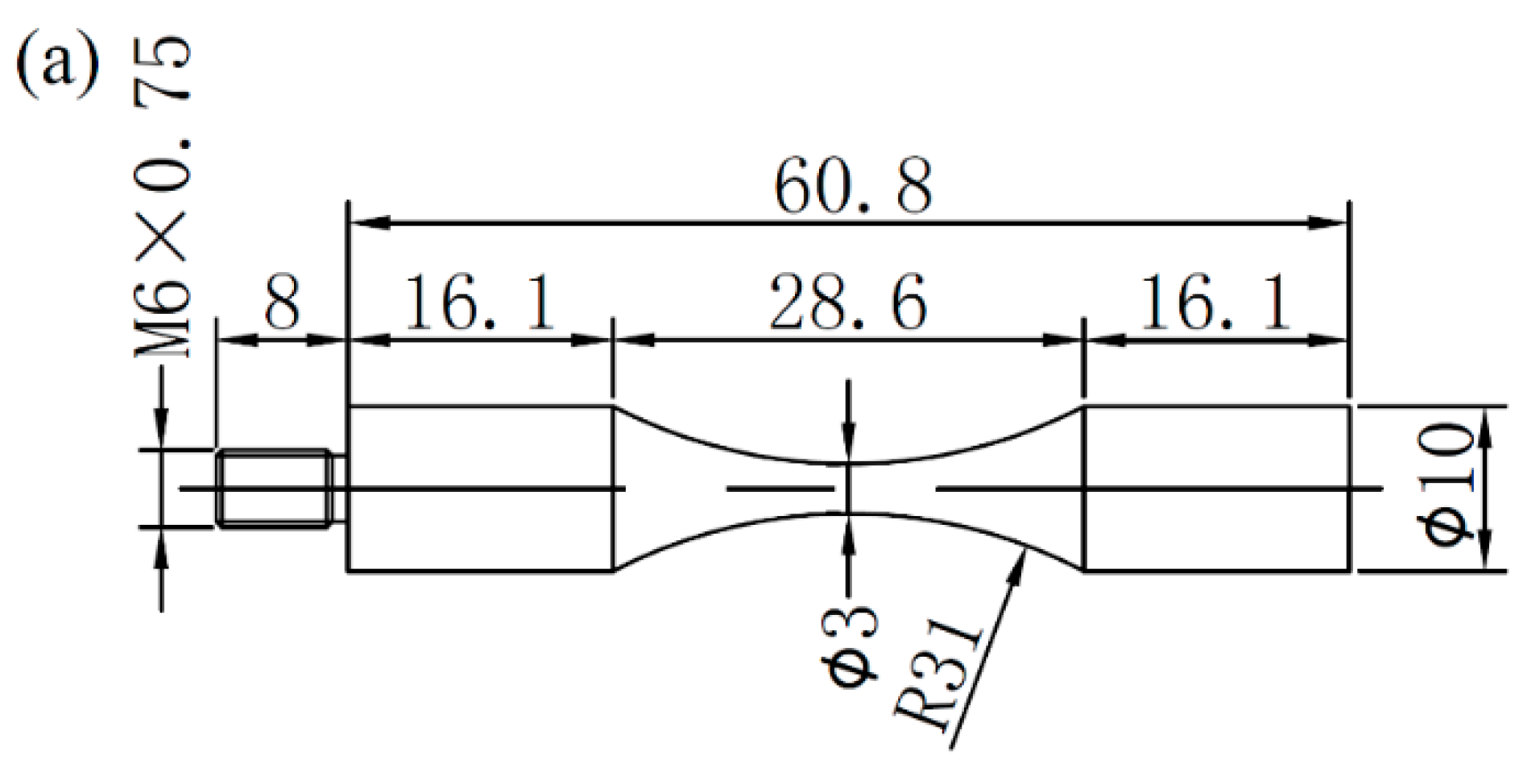
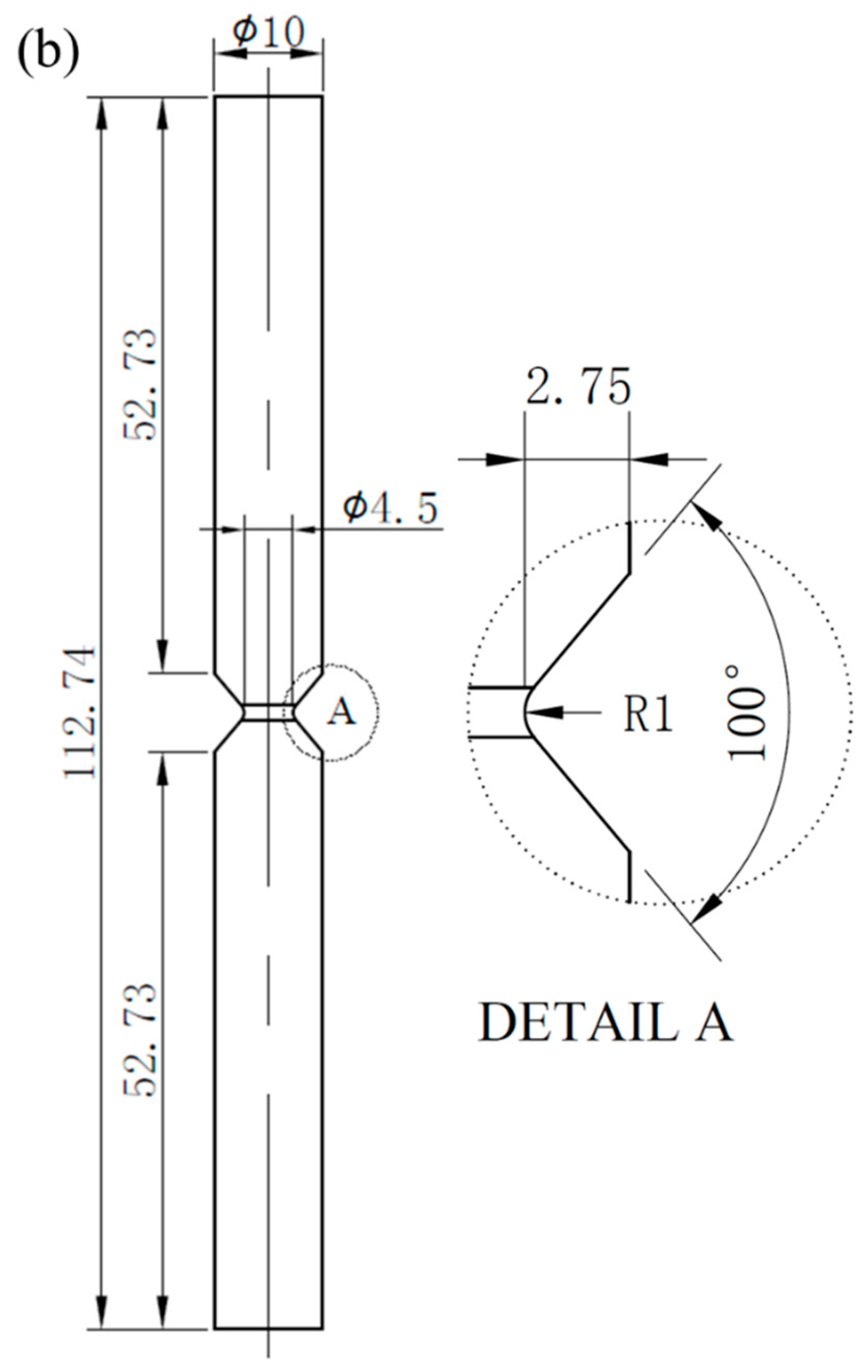
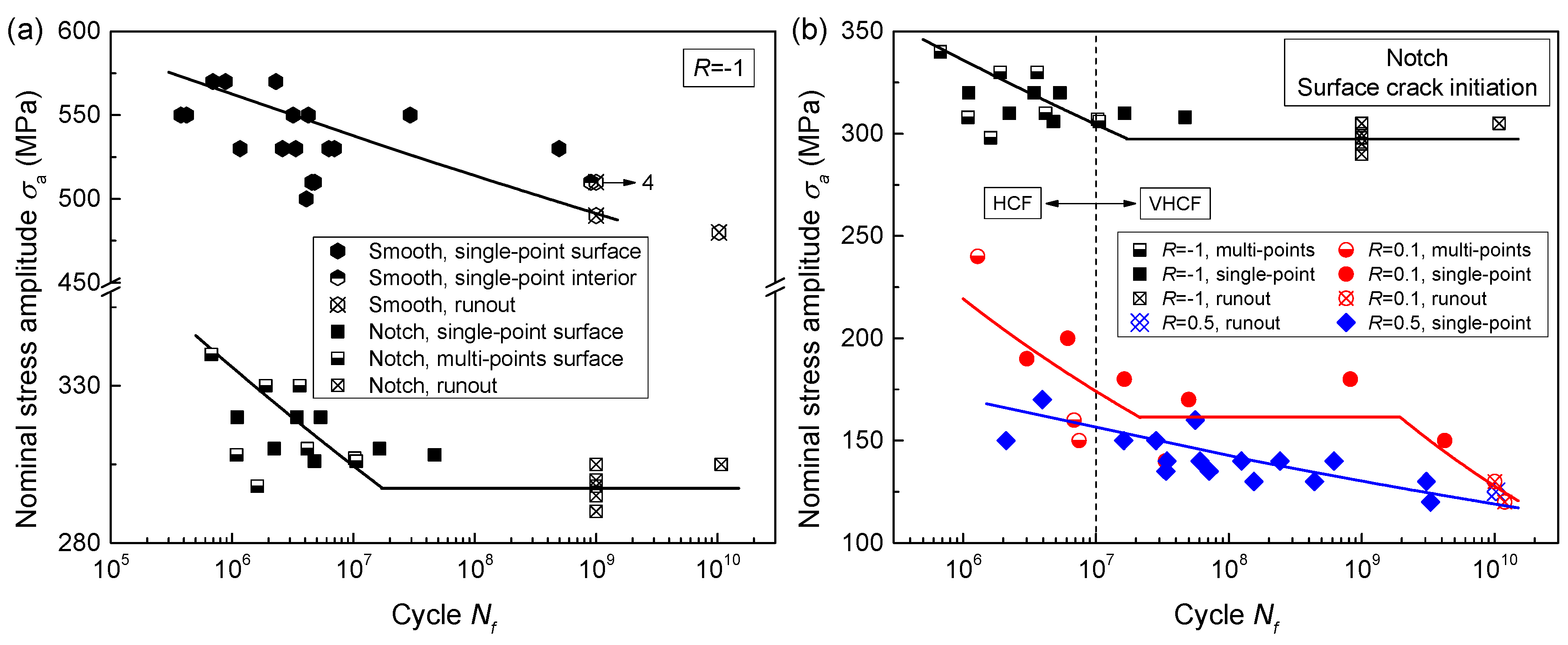
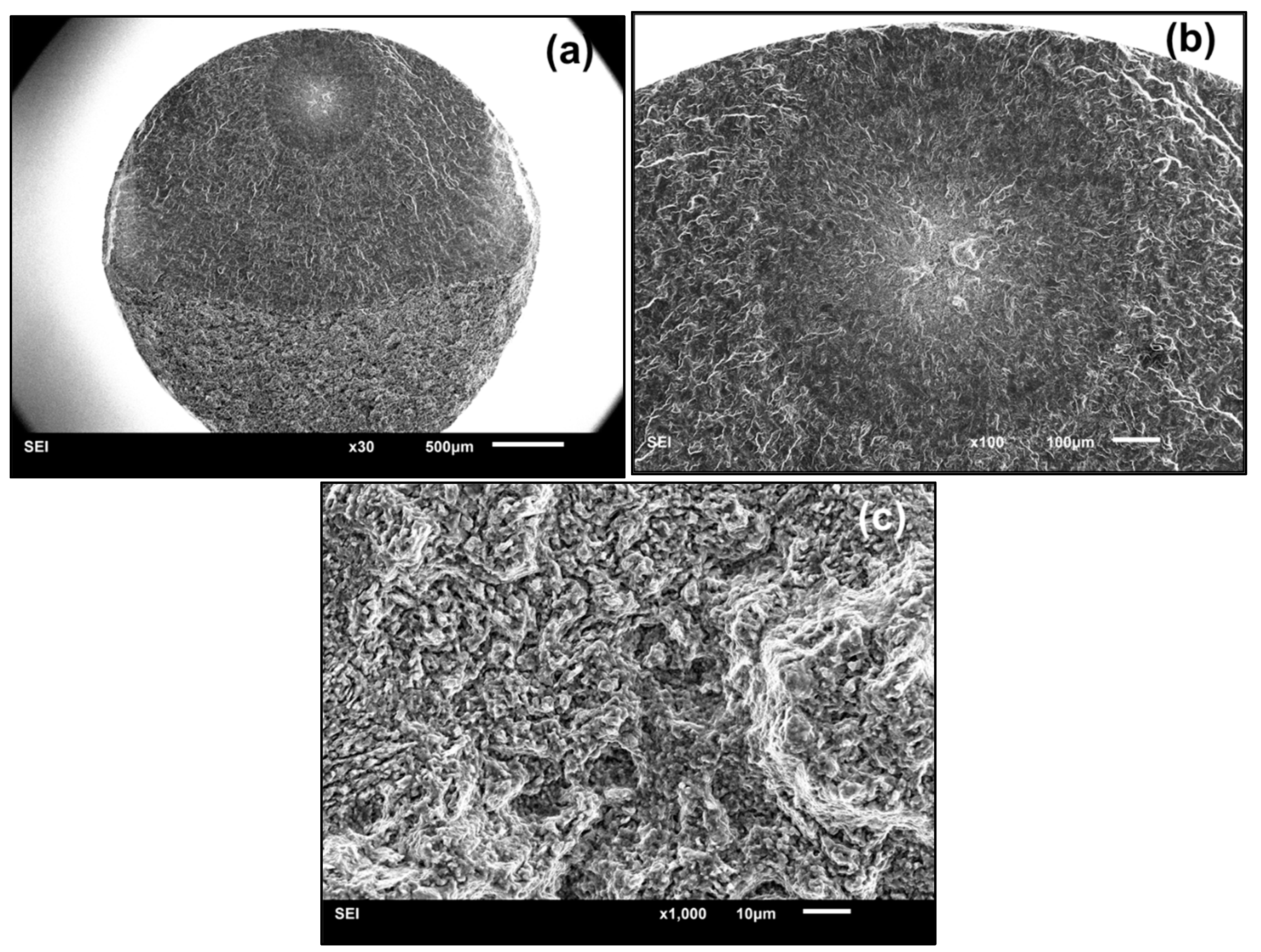
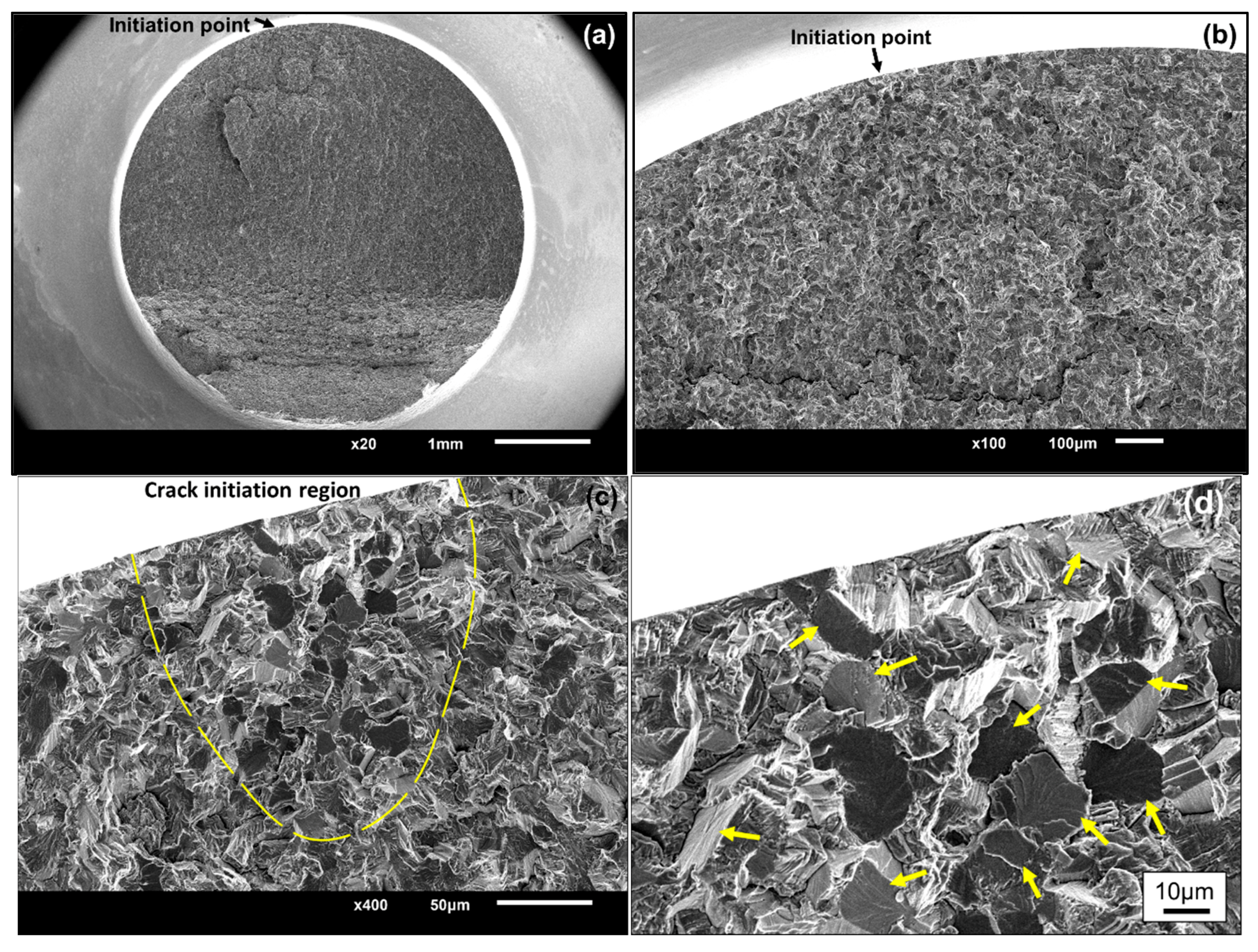
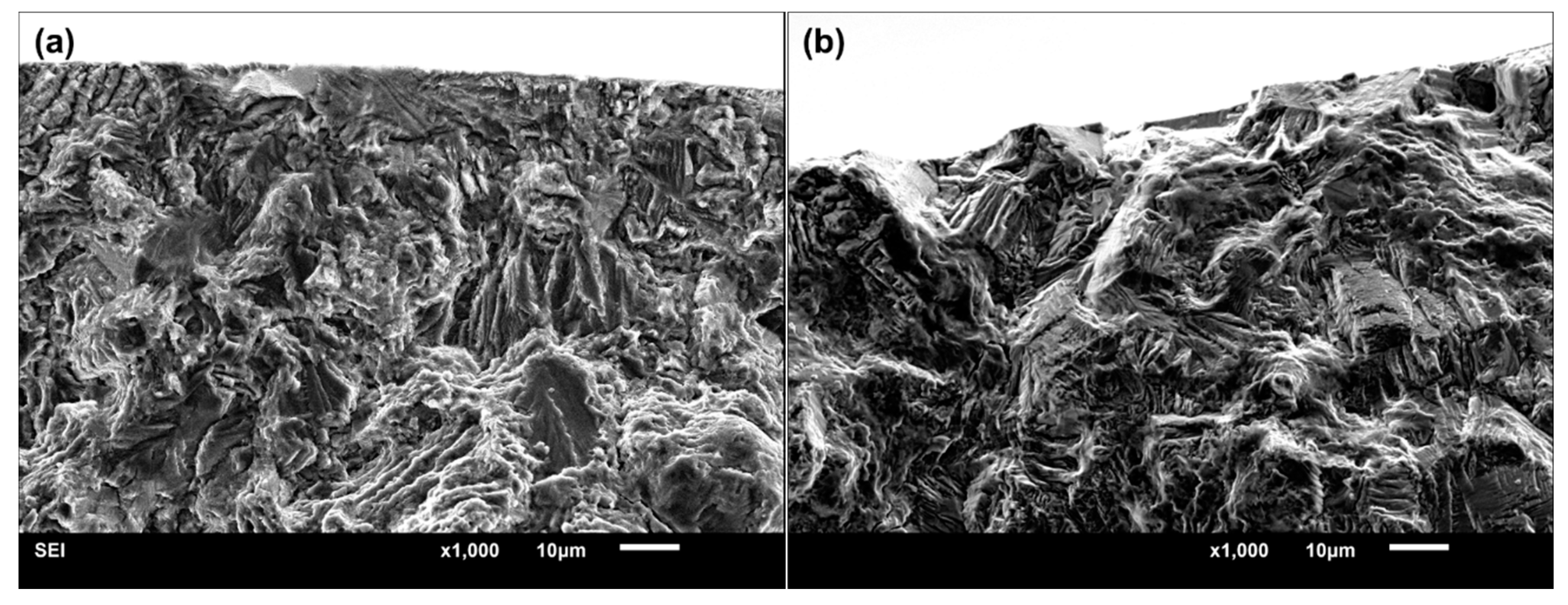
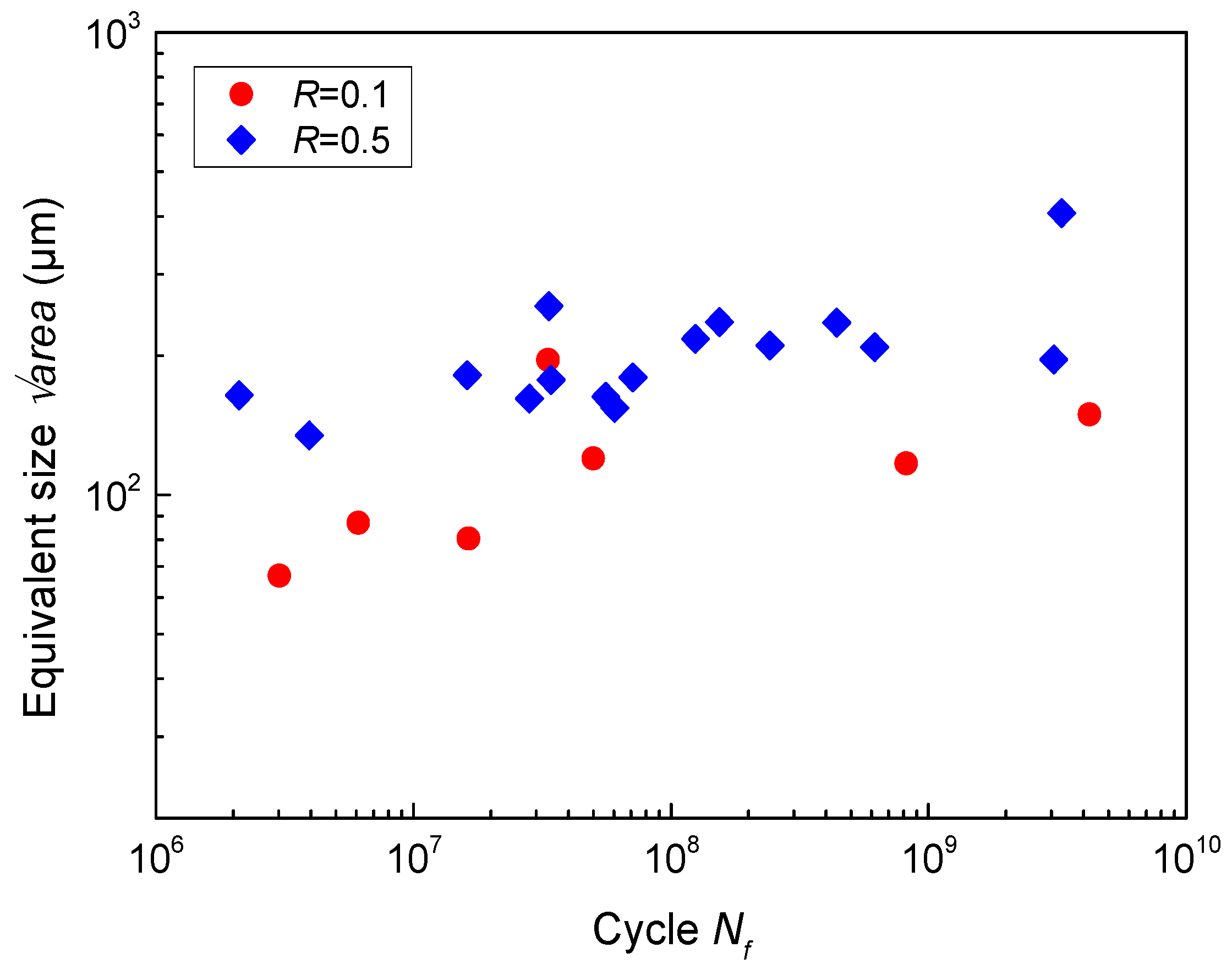

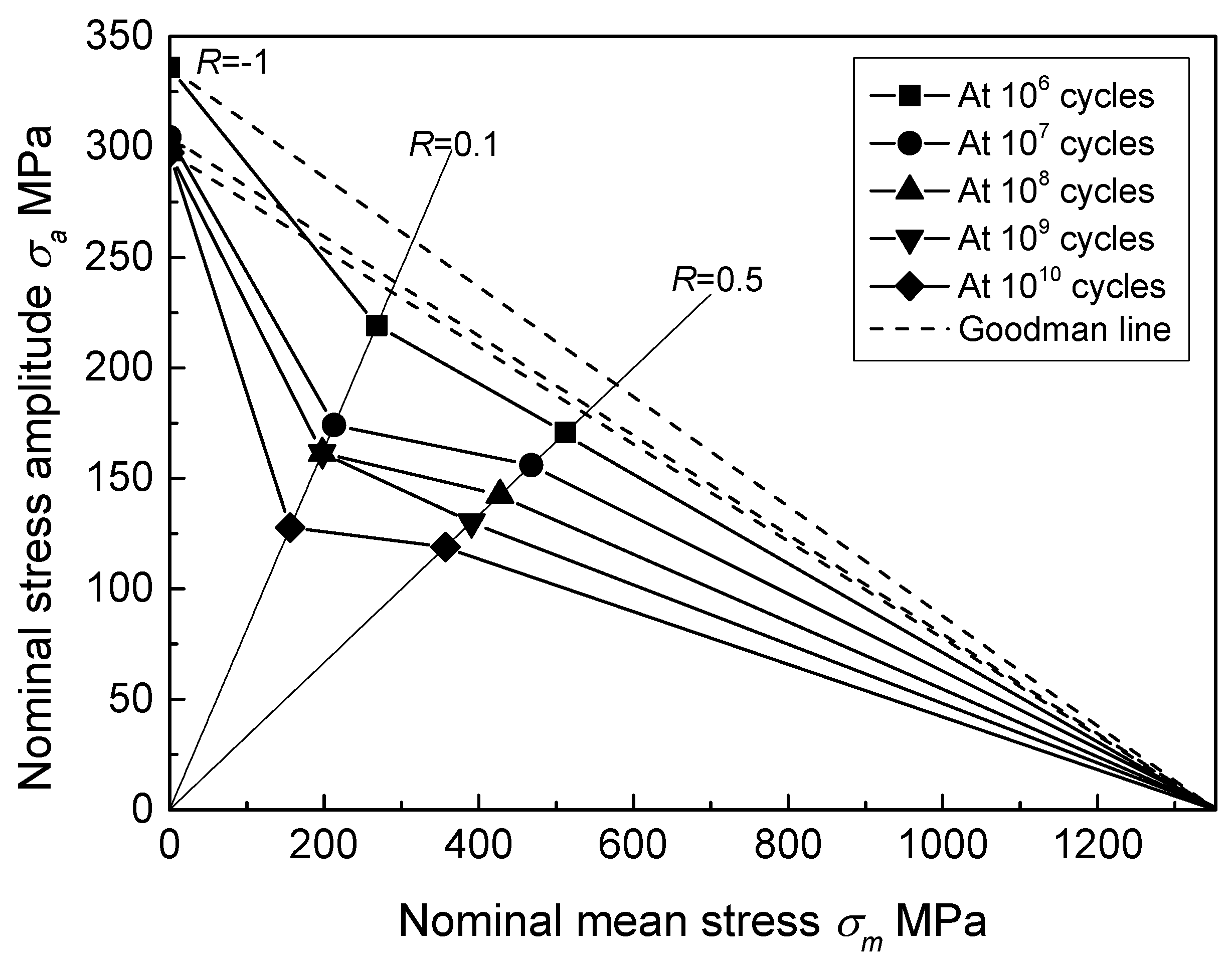
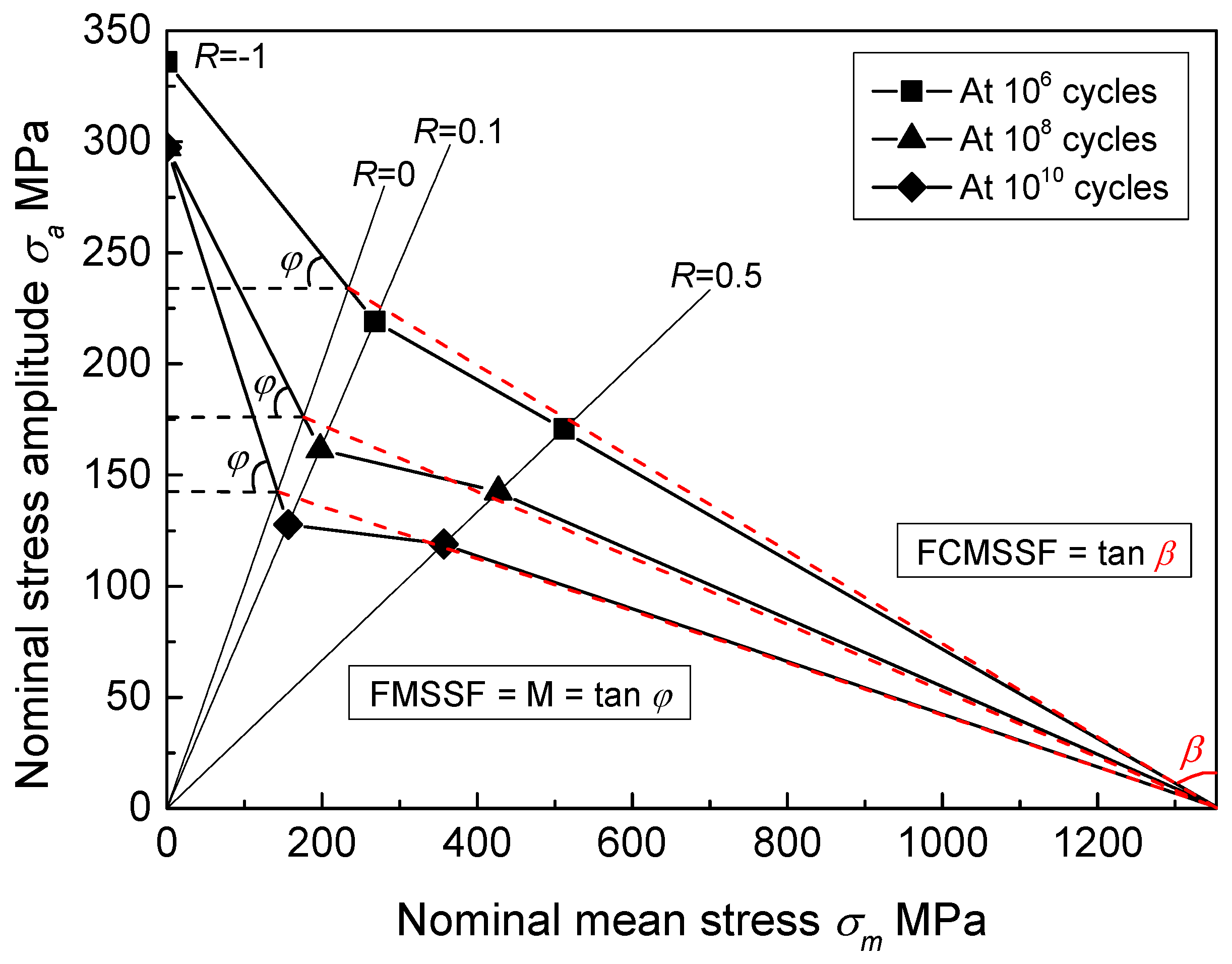
| Specimen Shape | Stress Ratio | 106 | 107 | 108 | 109 | 1010 |
|---|---|---|---|---|---|---|
| Smooth | −1 | 562.2 | 537.5 | 513.9 | 491.4 | - |
| Notch | −1 | 336.0 | 304.5 | 297.4 | 297.4 | 297.4 |
| 0.1 | 219.2 | 174.1 | 161.5 | 161.5 | 127.7 | |
| 0.5 | 170.7 | 156.0 | 142.5 | 130.2 | 119.0 |
| Fatigue Life | 106 | 107 | 108 | 109 | 1010 |
|---|---|---|---|---|---|
| FMSSF | 0.4357 | 0.6129 | 0.6885 | 0.6885 | 1.0868 |
| FCMSSF | 4.7817 | 6.1663 | 6.6817 | 6.6817 | 8.4937 |
| Specimen Code | Nf | σa (MPa) | σw [Equation (7)] (MPa) | σw [Equation (9)] (MPa) | Err. [Equation (7)] (%) | Err. [Equation (9)] (%) | |
|---|---|---|---|---|---|---|---|
| 9 | 2.106 × 106 | 164.0 | 150 | 189 | 138 | 26.0 | −7.8 |
| 1 | 3.940 × 106 | 134.4 | 170 | 195 | 143 | 14.9 | −15.9 |
| 16 | 1.618 × 107 | 181.4 | 150 | 186 | 136 | 23.9 | −9.3 |
| 3 | 2.820 × 107 | 161.5 | 150 | 189 | 139 | 26.3 | −7.6 |
| 11 | 3.358 × 107 | 256.0 | 135 | 175 | 128 | 30.0 | −4.9 |
| 6 | 3.424 × 107 | 177.2 | 140 | 187 | 137 | 33.2 | −2.5 |
| 2 | 5.579 × 107 | 163.1 | 160 | 189 | 138 | 18.2 | −13.5 |
| 7 | 6.048 × 107 | 154.0 | 140 | 191 | 140 | 36.4 | −0.2 |
| 12 | 7.114 × 107 | 179.3 | 135 | 186 | 136 | 37.9 | 0.9 |
| 5 | 1.244 × 108 | 217.4 | 140 | 180 | 132 | 28.8 | −5.7 |
| 13 | 1.543 × 108 | 236.3 | 130 | 178 | 130 | 36.8 | 0.1 |
| 10 | 2.423 × 108 | 210.3 | 140 | 181 | 133 | 29.5 | −5.2 |
| 17 | 4.401 × 108 | 235.5 | 130 | 178 | 130 | 36.8 | 0.2 |
| 4 | 6.177 ×108 | 208.6 | 140 | 182 | 133 | 29.7 | −5.1 |
| 8 | 3.062 × 109 | 196.1 | 130 | 183 | 134 | 41.1 | 3.3 |
| 14 | 3.289 × 109 | 406.7 | 120 | 162 | 119 | 35.3 | −0.9 |
© 2018 by the authors. Licensee MDPI, Basel, Switzerland. This article is an open access article distributed under the terms and conditions of the Creative Commons Attribution (CC BY) license (http://creativecommons.org/licenses/by/4.0/).
Share and Cite
Yang, K.; Zhong, B.; Huang, Q.; He, C.; Huang, Z.-Y.; Wang, Q.; Liu, Y.-J. Stress Ratio and Notch Effects on the Very High Cycle Fatigue Properties of a Near-Alpha Titanium Alloy. Materials 2018, 11, 1778. https://doi.org/10.3390/ma11091778
Yang K, Zhong B, Huang Q, He C, Huang Z-Y, Wang Q, Liu Y-J. Stress Ratio and Notch Effects on the Very High Cycle Fatigue Properties of a Near-Alpha Titanium Alloy. Materials. 2018; 11(9):1778. https://doi.org/10.3390/ma11091778
Chicago/Turabian StyleYang, Kun, Bin Zhong, Qi Huang, Chao He, Zhi-Yong Huang, Qingyuan Wang, and Yong-Jie Liu. 2018. "Stress Ratio and Notch Effects on the Very High Cycle Fatigue Properties of a Near-Alpha Titanium Alloy" Materials 11, no. 9: 1778. https://doi.org/10.3390/ma11091778




